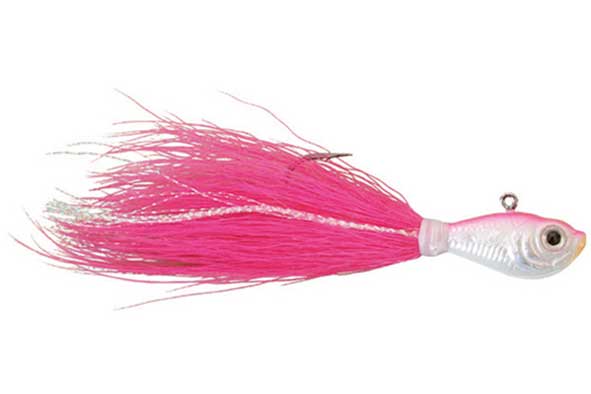Anyone who plans to learn about Chesapeake Bay fishing needs to know about bucktail jigs, and how to fish with them. But before we get to tactics and techniques, here's a quick video that will help give beginners an idea of what a bucktail is, and how to choose one.
Some may remember that five or six years ago, for whatever reason we humans can’t fathom, there was a stretch of time when a white bucktail sweetened with a three- to four-inch chartreuse paddle-tail or twister out-caught all the usual offerings made to stripers in the shallows and holding on structure. And old timers will remember when bottom-bouncing with bucktails sweetened with big bull minnow was the ticket to success. It’s always a good idea to keep bucktails onboard, and these things have been used by anglers since the dawn of angling. But just what are the most effective ways to employ them?
Casting and Retrieving to structure is one of the most common – and productive – uses for a bucktail. Fish it like any other jig, casting as close to the structure as possible and retrieving with plenty of twitches from the rod-tip. Maintain tension at all times, and when you see fish on the meter down deep, bounce it along bottom. Remember, however, that due to water resistance bucktails sink slower than straight plastic tails rigged to a leadhead. Accordingly, choose one with a head slightly larger and heavier that you otherwise might. Also note that few bucktails have “keepers” on the hook shank to hold your plastic in place, so a dab of lure glue is in order.
Light Tackle Trolling with bucktails can be very effective when fish are suspended or holding near the surface. Be sure to add a tail that has plenty of wiggle without added input from the angler. Generally speaking, paddle-tails are the top pick for this application.

Bottom Bouncing or Wire Lining is a method that’s used less often by modern anglers, but is just as effective today as it was in the good ol’ days. Rig a triple swivel to a braid or wire mainline, then add a 15-foot 40- to 50-pound mono leader terminating with the bucktail. Then put a three-foot dropper on the other eye of the swivel, with a 10- to 16-ounce sinker on the end. While you (slowly) troll over shoals and humps an angler must actively work each rod, sweeping the tip forward then dropping it back so the weight bounces on bottom at the end of the back-swing. The angler will also have to constantly crank in and let out line to keep the right amount out as the depth varies. For some strange reason, this often works best with a big bull minnow lip-hooked on the bucktail, as opposed to dressing it with plastic.
Vertical Jigging a bucktail is sometimes the ticket to success, usually when the fish are sitting in deep water near or on bottom and they seem to have lockjaw for one reason or another. In this case leave the plastics in the tacklebox, and use either one of those bull minnow, a chunk of peeler crab, or a strip bait to give the bucktail some added appeal. Then give it a slow jig bumping bottom on the down-swing as you drift. This is a great tactic to apply when there’s a mixed-bag of species around, since a baited, slowly-jigged bucktail is attractive to virtually all species of fish ranging from rock to flounder to weakfish to cobia.